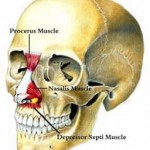The nose can have many shapes and they are most commonly perceived from a static standpoint. Since the nose is usually thought of as having a stable shape, it is not often seen as having a change in shape with dynamic facial motion. But the smiling deformity of the nose is well known with the tip of the nose being pulled down with facial motion, particularly smiling or laughing, due to contraction of the depressor septi muscle.

In the June 2014 issue of the JAMA Archives of Facial Plastic Surgery, an article appeared entitled ‘Effect of Depressor Septi Resection in Rhinoplasty on Upper Lip Length’. In this paper, the effects of depressor septi resection were studied to determine if it caused any measurable change in the length of the upper lip at rest. Based on 36 patients that had a rhinoplasty that included depressor septi resection, the percent change in upper lip length was measured on before and after photographs taken on average seven months after surgery. Two-thirds of the patients (24) had a decrease in lip length (21%) while the remaining third (12) had an increase (13%) in upper lip length. They concluded that depressor septi resection had an unpredictable effect on upper lip length and a postoperative increase or decrease in upper lip length can occur in any patient.
Some patients report that while treatment of the smiling deformity or drooping tip by depressor septi muscle resection is effective, it can cause an undesireable upper lip lengthening effect. Contrary to these reports, this descriptive study reports a small but variable effect on upper lip length at rest.
Dr. Barry Eppley
Indianapolis, Indiana


